15 December, 2002
The second transect done at New Harbor where the Taylor Valley meets the Ross
Sea Ice.
After getting settled in at the New Harbor field camp, we planned the first
sampling of the second transect since it is only about 2:30 p.m.. Scott led the
discussion by telling us that we need to get the highest samples first because
the weather is clear and we might not be so lucky if we wait. The next
decision is which side of the valley to start the sampling. Since we would
like to get up to a glacier, we opt to start with the south side where a
glacier is close to our collection spot. At least it looks close from the
field camp.
Dead reckoning Scott, with GPS in hand and on his back since the equipment
itself weighs 25 lbs., lead the way as we work our way up and down toward the
300 meter mark. With the valley being 5 miles wide, we have a ways to go.
Shortly after leaving the field camp, we come to several steep moraines of
loose footing. Some of the team suggest that we go around these, however,our
dead reckoning leader goes straight ahead following the coordinates carefully.
He is engrossed with his equipment, which is really amazing when one considers
where we are. Since we all follow the environmental protection laws for the dry
valleys, we walk single file across the valley and up and over numerous slopes
faithfully following our GPS leader.
Many times we are stopped by one of us exclaiming "look at this one"! We are
intrigued by all of the beautiful rocks and ventifacts. Ventifacts are rocks
carved into graceful shapes by being blasted by strong winds over centuries of
time. The rocks are beautiful! Rusty suddenly shouts, hey look at the
aboriginal tools left here! We know he is just kidding, but we do hurry up to
see what he has found. Indeed there is a rock that looks just like a crucible
where people might have used such a tool to grind grain. We speculate when
anything larger than microscopic organisms might have lived on the continent.
If you know any scientists, them you can imagine the fun we have activating
vivid imaginations.
Shortly, Rusty calls out again. This time he has found a bed of moss growing in
the soils. Rusty has a strong interest in symbiosis and thinks that there is a
chance that symbiosis might be in effect here. We carefully continue. I am
amazed at the fabulous observational skills of team members.
Time for a snack break and a potty break - well, a Pee bottle break - there are
some large rocks that can serve as the "bush" one goes behind to urinate when
out on a long hike. Here, we leave nothing but footprints. The women have a
new gismo called a Lady J that making urinating easier with out exposing you
body to the cold wind. This is a great invention and we all agree that it works
quite well! After a snack and some hot soup, we move on to the collection
site.
Methods are the same as the first transect. Scott stops, says here and we begin
to measure the 20 meter square. Again Scott helps us orient North/South, then
we rotate keeping the center 10 meter mark at the same spot. (Laurie does this)
We then align the East/West line and plant the blue flags. Now we begin the
sampling. The wind is picking up and clouds seem to be moving in. We really
appreciate that is is not going to be getting darker as it gets later.
Why is this true?
It is about 8:00 p.m. before we get back to the field camp. Regina begins to
cook a great dinner while the rest of us take care of the samples. One can
appreciate why you need to be physically qualified by a medical team at home
before you are given final approval to come to Antarctica. The hiking we did
today is just one example of why one needs to be in good shape. If you are
thinking about how you might get to the dry valleys some time, you need to be
in good physical shape. We relax with an excellent dinner of pesto pasta and
scallops with broccoli. This is a great place.
Now it is your turn to think a bit. Can you with your friends write up the
protocol (procedure) we used to do the sampling?
What equipment will we use?
How did we keep the equipment sterile?
Why do we need to worry about keeping equipment sterile?
How do we keep track of the samples? What label would you make for each baggie?
If you need some help, check out the pictures.
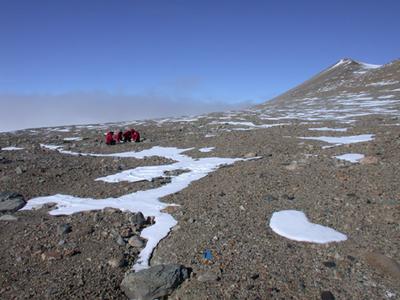
Can you find the blue marker flag? Can you find more than one flag? Why do we use the flags?

Why do we use the aerobie? We take turns tossing the aerobie and hope the wind doesn't catch it and take it our of bounds. What is the boundary for us?

What equipment are we using here? How much sample do we need to get? How should we label each sample? How can we keep track of all our samples? Can you tell what job each of us has?
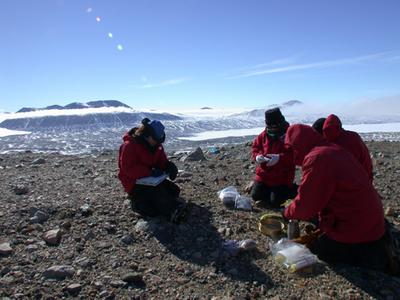
We age bagging the samples here. Why are we wearing gloves? (not just because it is cold) How do you think the baggie is sealed so it doesn't leak?
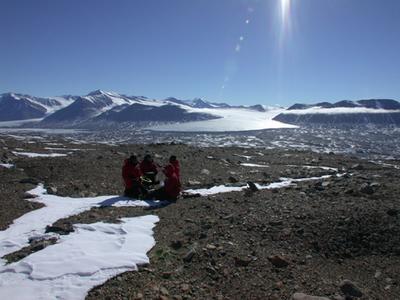
Do you think we have hiked high enough to be above the 300 meter mark for our first sample?

As we look up from our collecting, we see the commonwealth glacier across the valley. It looks close . Do you know about how far away the edge of the glacier really is?
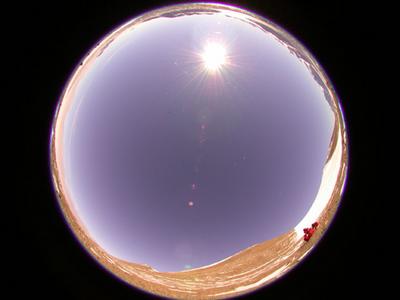
What kind of photo is this? Scott takes one of these pictures at each sampling site. Why? Can you tell what time it might be?
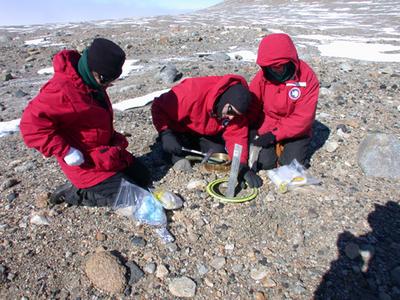
What are we measuring here? What equipment are we using? Why are we taking this measurement? What units of measure do you think we are using?
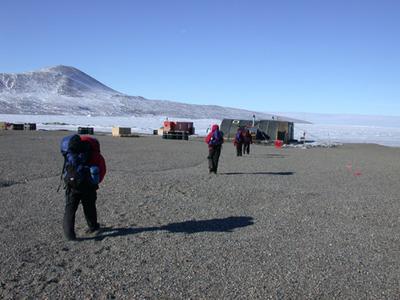
Back to the field camp, we are tired and hungry. Notice how we are all walking in each others footprints. If we are careful, there will be only one small line of footprints left by our careful research team. Why don't we walk side by side so we can talk leisurely with each other?
Contact the TEA in the field at
.
If you cannot connect through your browser, copy the
TEA's e-mail address in the "To:" line of
your favorite e-mail package.
|
